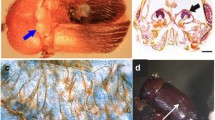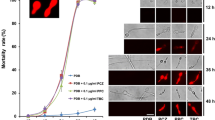Abstract
General characteristics of ambrosia fungus-beetle mutualism are described and recent trends for innovative research briefly indicated. Techniques to locate, collect, transport, maintain, isolate, and study fungi and beetles in the field and in vitro are reviewed in detail. A synthetic basal medium for growing ambrosia fungi is described; this should enable researchers to investigate nutrition and enzymology of both the symbionts.
Similar content being viewed by others
References
Batra L R 1959 A comparative morphological and physiological study of the species ofDipodascus;Mycologia 51 329–355
Batra L R 1963a Ecology of ambrosia fungi and their dissemination by beetles;Trans. Kansas Acad. Sci. 66 213–236
Batra L R 1963b Habitat and nutrition ofDipodascus andCephaloascus;Mycologia 55 508–520
Batra L R 1966 Ambrosia fungi: extent of specificity to ambrosia beetles;Science 153 193–195
Batra L R 1967 Ambrosia fungi: a taxonomic revision, and nutritional studies of some species;Mycologia 59 976–1017
Batra L R 1979 (ed.)Insect-fungus symbiosis: nutrition, mutualism and commensalism (Montclair, New Jersey: Allenheld, Osmun and Co.) pp. 276
Batra S W T and Batra L R 1967 The fungus gardens of insects;Sci. Am. 217 112–120
Brader L 1964 Etude de la relation entre le scolyte des rameaux du caféier,Xyleborus compactus Eichh. (X. morstatti Hag.), et sa plante-hote;Meded. Landbouwhogesch. 64(7) 1–109
Bridges J R 1983 Mycangial fungi ofDendroctonus frontalis (Coleoptera: Scolytideae) and their relationship to beetle population trends;Environ. Entomol. 12 858–861
Chararas C 1981 Origin and specificity of certain cellulases and hemicellulases in different xylophage insects;C. R. Seances Acad. Sci. Ser. III Sci. Vie 293 211–214
Francke-Grosmann H 1956 Haudrüsen als Träger der Pilzysymbiose bei Ambrosiakäfern;Z. Morphol. U. Ökol. Tiere 45 275–308
Francke-Grosmann H 1963 Some new aspects in forest entomology;Ann. Rev. Entomol. 8 415–438
Francke-Grosmann H 1967 Ectosymbiosis in wood-inhabiting insects. InSymbiosis (ed.) S M Henry (New York: Academic Press) Vol. 2 pp. 141–205
French J R J and Roeper R A 1972 In vitro culture of the ambrosia beetleXyleborus dispar (Coleoptera: Scolytideae) with its symbiotic fungus,Ambrosiella hartigii;Ann. Entomol. Soc. Am. 65 719–721
French J R J and Roeper R A 1973 Patterns of nitrogen utilization between the ambrosia beetleXyleborus dispar and its symbiotic fungus;Insect Physiol. 19 593–605
Gadd C H and Loos C A 1947 The ambrosia fungus ofXyleborus fornicatus Eichh;Trans. Br. Mycol. Soc. 31 13–18
Kalshoven L G E 1958 Studies on the biology of Indonesian Scolytoidea;Entomol. Ber. 18 147–193
Kaneko T 1965 Biology of some scolytid ambrosia beetles attacking tea plants. I. Growth and development of two species of scolytid beetles reared on sterilized tea plants;Jpn. J. Appl. Entomol. Zool. 9 211–216
Kok L T and Norris D M 1973 Comparative sterol compositions of adult femaleXyleborus ferrugineus and its mutualistic fungal ectosymbionts;Comp. Biochem. Physiol. B44 499–505
Lindgren B S and Borden J H 1983 Survey and mass trapping of ambrosia beetles (Coleoptera: Scolytideae) in timber processing areas on Vancouver Island;Can. J. For. Res. 13 481–493
Lodder J 1970 (ed.)The yeasts, a taxonomic study; (Amsterdam: North-Holland Publishing Co.) pp. 1385
Magema N, Gasper C and Severin M 1982 Efficacity of ethanol for trappingTrypodendron linneatum (Coleoptera: Scolytideae) and the influence of thePicea terpenics;Ann. Soc. R. Zool. Belg. 112 49–60
Martin M M 1984 The role of ingested enzymes in the digestive processes of insects. InInvertebratemicrobial interactions (eds) J M Anderson, A D M Rayner and D W H Walton (London: British Mycological Society Symposium 6) 155–172
Muthappa B N and Venkatasubbaiah P 1981 Association ofAmbrosiella macrospora withXylosandrus compactus, the shot-hole borer of robusta coffe (Coffea canephora) in India;J. Coffee Res. 11 54
Nakashima T 1972 Notes on the mycetangia of the ambrosia beetles,Platypus severni Blandford andP. Calamus Blandford (Coleoptera: Platypodideae);Appl. Entomol. Zool. 7 217–225
Nakashima T 1975 Several types of the mycetangia found in platypodid ambrosia beetles (Coleoptera: Platypodideae);Insecta Matsumurana NS 7 1–69
Nakashima T 1979 Notes on the time when the new female adults of the ambrosia beetleCrossotarsus niponicus Blandford (Coleoptera: Platypodideae) harvest their symbiotic fungi into their mycetangia;Insecta Matsumurana. NS 17 1–19
Norris D M and Baker F M 1969 Nutrition ofXyleborus ferrugineus. I. Ethanol in diets as a tunnelling (feeding) stimulant;Ann Entomol. Soc. Am. 62 592–594
Nobuchi A 1972 The biology of Japanese Scolytideae and Platypodideae (Coleoptera);Rev. Plant Prot. Res. 5 61–75
Schneider L A and Rudinsky J A 1969a Mycetangial glands and their seasonal changes inGnathotrichus retusus andG. sulcatus;Ann. Entomol. Soc. Am. 62 39–43
Schneider L A and Rudinsky J A 1969b Anatomical and histological changes in internal organs of adultTrypodendron lineatum, Gnathotrichus retusus, andG. sulcatus (Coleoptera: Scolytideae);Ann. Entomol. Soc. Am. 62 995–1003
Singh P 1977Artificial diets for insects, mites and spiders; (New York: Plenum Press) pp. 494
Weber B C and McPherson J E 1983 Life history of the ambrosia beetleXylosandrus germanus (Coleoptera: Scolytideae);Ann. Entomol. Soc. Am. 76 455–462
Author information
Authors and Affiliations
Rights and permissions
About this article
Cite this article
Batra, L.R. Ambrosia beetles and their associated fungi: research trends and techniques. Proc. Indian Acad. Sci. 94, 137–148 (1985). https://doi.org/10.1007/BF03053133
Issue Date:
DOI: https://doi.org/10.1007/BF03053133




